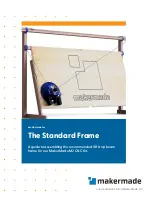
11
11
English
Operation
and functioning
3
Regulation and adjustment
3.1
3.1.1 Adjusting the cutting depth
•
This adjustment is to be made each time the milling
cutter and tracer point are changed.
•
The procedure for making this adjustment is detai-
led in point “2.3.5” of this manual.
3.1.2 Tracer point flexibility
•
The tracer point can be positioned below its adjust-
ment position, when it is in flexible mode.
•
This tracer point location enables the milling cutter
descent to be guided during the key cutting opera-
tion. The tracer point is gradually inserted in each
of the holes in the original key to be duplicated.
When the tracer point is inserted in its correspon-
ding hole, the milling cutter has not yet begun to
machine they key. When the milling cutter begins
to cut the key, the machine head is guided by the
tracer point, thus preventing the milling cutter
from accidentally going off course.
•
The functioning of this system is explained in point
2.3.4 of this manual.
Cutting keys
3.2
3.2.1 Cutting SEA-1 keys
•
Milling cutter and tracer point F-1 / P-1 are used for
cutting the side points of the keys, and the points
are cut normally.
•
Milling cutter and tracer point F-3 / P-3 are used for
cutting the grooves in the key blade. The grooves
are cut as follows:
- Adjust the heights of the milling cutter and tracer
point, and take the tracer point out of flexible
mode.
- Lower the tracer point slightly by turning the
corresponding adjustment wheel (around 1/10 of
a turn).
- Insert the tracer point in the groove in the key
blade and lock the machine head.
- Raise the tracer point slightly so that it does not
drag the key.
- Guide the tracer point along the centre of the
groove without touching the sides. On the second
run, the tracer point should enter from the right
and exit by the left. Do not exert pressure (just
rest the tracer point lightly on the key).
For safety during the cutting operation, the following
points must be observed:
Always work with dry hands.
Ensure the earth is connected.
Wear protective goggles.
All key clamping and releasing operations must be
done with the machine switched off.
1
2
3
4
See figure 9
3.2.2 Cutting OP-WH.P and OP-WY.P type keys
•
Milling cutter and tracer point F-11 / P-11 are used
for cutting these keys.
•
Clamp the original key and the new key in the
clamp, making a tip stop.
•
Adjust the heights of the milling cutter and tracer
point, and take the tracer point out of flexible
mode.
See figure 10
3.2.3 ME-3.P and ME-4.P type keys
•
Milling cutter and tracer point F-11 / P-11 are used
for cutting these keys.
•
To clamp the keys in the clamps, adaptor AD-MM2
will need to be used (see diagram).
- Place the adaptors on the clamp.
- Insert the two keys in their respective adaptors.
- Fit the adaptor to the clamp until it reaches its limit.
The key will then be clamped in its adaptor.
•
Adjust the heights of the milling cutter and tracer
point, and take the tracer point out of flexible
mode.
•
Lower the tracer point very slightly by turning the
corresponding adjustment wheel (around 1/10 of a
turn).
•
Insert the tracer point in the groove in the key
blade and lock the machine head.
•
Raise the tracer point slightly so that it does not
drag the key.
•
Make the first key-cutting run.
•
As these keys are reversible, only turn the key to be
cut, making the second run on this key.
See figure 11
3.2.4 JIS-4.P keys
•
Milling cutter and tracer point F-11 / P-11 are used
for cutting these keys.
•
To clamp the keys in the clamps, adaptor AD-MJ
will need to be used (see diagram).
- Position the adaptors and fix them to the clamp.
- Insert the two keys in their respective adaptors
(until they reach their limit on the turning plate,
against the key stops). In this position, clamp the
keys to their adaptors.
•
Adjust the heights of the milling cutter and tracer
point, and take the tracer point out of flexible
mode.
•
Make the first cutting run.
•
Turn the two keys on the other side of the adaptor,
and proceed as described in the above process for
placing the keys.
•
Make the second run.
See figure 12
3.2.5 WIN-1D, WIN-2D, WIN-3D and WIN-4D keys
•
Milling cutter and tracer point F-15 / P-15 are used
for cutting these keys.
•
Clamp two flat key blanks in the clamp, and use
them to adjust the heights of the milling cutter and
tracer point.
•
Take the tracer point out of flexible mode, and
take out the two flat key blanks.
•
To clamp the keys in the clamps, the “Winhaus
template P-WIN” adaptor will be needed (see
diagram).
- Position the adaptors on the clamp.
See figure 13
•
Lower the tracer point very slightly by turning the
corresponding adjustment wheel (around 1/10 of a
turn).
•
Insert the tracer point in the groove in the key
blade and lock the machine head.
•
Raise the tracer point slightly so that it does not
drag the key.
•
It is recommendable to make a preliminary rough-
grinding run and then another finishing run,
following the whole marking profile of the key.
Machine it downwards (from the tip to the head of
the key).
Содержание DAKKI
Страница 1: ......































